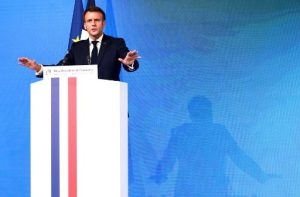
ICU Weekly Insight: 8 November 2022 – Kyiv Post
Bonds: Trading in UAH bonds increases due to reinvestment
The secondary bond market became more active, most likely thanks to those who reinvested proceeds that were redeemed last week. However, the effect is unlikely to be long-lasting.
Last week, the Ministry of Finance continued to raise interest rates in the primary market and increased the rate on five-month military bills by 150bp to 13.5%. Thanks to this, the MoF managed to attract almost UAH12bn (US$326m) to the budget via placement of this paper. See details in the auction review. The new interest rate is still significantly lower than the yield of paper available on the secondary market. Therefore, the demand at the auction likely originated from just several large banks, as all securities sold last Tuesday saw sparse and low trading on the secondary market.
At the same time, trading in the secondary market was mainly in ordinary (non-military) bills. Out of 13,207 deals that amounted UAH4.4bn (US$120m), 2,268 deals for UAH4.1bn (US$111m) were non-military securities. Activity was the highest on Thursday after investors received funds from the redemption of military bills placed between March and May this year. According to the NBU, the largest trading amounts were for ordinary (non-military) government bonds maturing in February and April 2023, which exceeded UAH1bn (US$27m). But the most-frequent traded military bills were those maturing next June and October—more than 4,000 deals of each.
ICU view: After about UAH20bn (US$547m) worth of bonds were redeemed last Wednesday, many investors chose to reinvest new liquidity into ordinary bills in the secondary market since it offers yields above those in primary auctions. Even foreigners became more active, and they were the only group of investors who increased their local-currency portfolios last week. The portfolios of other groups decreased due to redemptions.
At the primary auction tomorrow, the Ministry will offer the same UAH securities as last week, including ordinary (non-military) bills that were sold with interest rates of 18.5%. It is possible that they may receive greater demand thanks to liquidity from last week’s repayments, but demand is still unlikely to be very significant.
Bonds: Pressure on Eurobonds persists due to damaged infrastructure
Last week, prices of Ukrainian Eurobonds continued to fall and reached a new record low since the beginning of the full-scale Russian invasion.
The risk of interruptions in the electricity supply to households and businesses persist. An unstable electricity supply could further deepen the decline in GDP and lead to lower tax revenues in the coming quarters. Since risks to economic growth have become higher in recent weeks, the yields of Eurobonds grew apace. Yield spreads on most of Ukrainian Eurobonds to the benchmark widened by about 250bp, and sharply by 1,133bp for bonds maturing in 2024. Another factor was the decline in US Treasuries prices, which are the benchmark for Ukrainian sovereign bonds.
As a result, the prices of Ukrainian Eurobonds fell last week by 5‒8% to 15‒24 cents, and many of them reached a new low since the full-scale invasion.
ICU view: Pressure on Eurobond prices persisted last week as electricity supply disruptions became a new, permanent negative factor for the Ukrainian economy. Ukrainian energy companies have already installed most reserve equipment inventories for emergency recovery and new supplies of equipment are now expected from European partners. Risks of new missile strikes on energy infrastructure will remain high until Ukraine’s air defense is strengthened.
FX: Hryvnia exchange rate rolls back slightly after significant gains
The hryvnia exchange rate weakened slightly last week against the US dollar, somewhat rolling back after a significant strengthening at the end of October.
Thanks to the saturation of the cash market, the hryvnia exchange rate strengthened rapidly at the end of October to less than UAH40/US$. Nonetheless, last week, it weakened slightly. In the leading retail banks, the USD rose in price by UAH0.3‒0.4, from UAH39.1‒40.0/US$ to UAH39.5‒40.3/US$.
In the interbank market, the balance of supply and demand among bank customers worsened, and demand even more outweighed supply. This led to an increase in NBU interventions to US$394m.
ICU view: Another wave of shelling and destruction of energy infrastructure catalyzed a new wave of demand for hard currency, which, however, was not strong and lasted only a few days. By the end of last week, the FX market stabilized. So, although the hryvnia exchange rate has weakened compared with the previous week, it remains stronger than it was in October. Fluctuations remain relatively small by the standards of war time and depend mainly on temporary factors.
Economics: Current account in hefty surplus on better trade balance, foreign grants
Ukraine’s current account (C/A) remained in hefty surplus of US$1.9bn in September thanks to improvement in trade-in-goods balance and large foreign grants.
The most notable observation from September’s C/A is a significant improvement in trade-in-good balance thanks to increased exports of agricultural commodities via Black Sea ports. The total trade balance was still significantly negative at US$2.2bn but was more than offset with inflows of migrant remittances (US$1.2bn) and grants that represent foreign financial aid to Ukraine (US$2.1bn). The 12-month trailing C/A surplus to September reached US$6.6bn.
The financial account balance ended up at negative US$2.6bn in September. The two key channels of capital outflows remain unchanged: build-up of trade credits at US$1.2bn and FX cash withdrawal from banks at US$1.2bn. Concessional lending to Ukrainian government was minimal in September and was far from enough to offset capital outflows from the private sector.
The NBU reserves were down 6% MoM in September to US$23.9bn.
ICU view: September balance-of-payments data did not bring any material surprises. Trade-in-goods balance expectedly improved thanks to Black Sea grain corridor but Ukraine’s external accounts (net of foreign grants and loans) remain deeply negative and the economy remains heavily reliant on international financial assistance. The situation is unlikely to change any time soon but the good news is that the government seems to have secured substantial financial aid commitments from the US and the EU that should be more than sufficient for the economy to avoid balance-of-payments crisis at least through end-2023.
Economics: Parliament approves 2023 budget
Last week, the Parliament approved 2023 state budget with a deficit of US$31bn. The parameters of the final document are little changed from the numbers approved in the first reading.
The document foresees that tax and non-tax budget revenues will cover just 52% of total expenditures and that is broadly in line with the YTD numbers for 2022. The state budget deficit will total UAH1,297bn (US$31bn at an average UAH42.2/US$ exchange rate projected by the government). This amounts to about 21% of 2023F GDP by government estimates. The deficit is planned to be covered with net external borrowings of US$36bn, while net repayment of local debt will be US$5.3bn. Government said it does not plan to rely on direct financing from the NBU next year.
ICU view: The funding of state budget will be totally dependent on external concessional funding from Ukraine’s allies. The budget plan conservatively assumes that all financial aid from abroad will come in the form of loans, while a substantial part of it may come in the form of grants. If Ukraine receives grants, they will be treated as budget revenues, thus automatically reducing the fiscal gap. So far, the financial aid commitments of the US and the EU for 2023 already reached US$36bn which is nearly sufficient to cover the budget deficit. However, Ukraine may need much more should economic situation worsen due to unexpected significant war-related events. In that case, the IMF or other IFIs/governments may step in to increase the total volume of budget support.
RESEARCH TEAM: Vitaliy Vavryshchuk, Alexander Martynenko, Taras Kotovych
See the full report here.


Average Rating